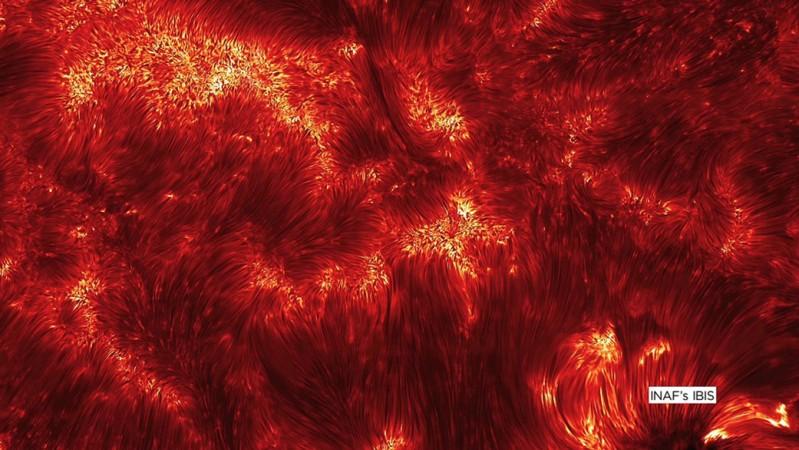
The emission of solar materials from the Sun's surface has been a mystery so far. Around 10 million wild jets of solar material are discharged from Sun's surface.
Also Read: NASA's Hubble spots dead disk-shaped galaxies
These solar jets are emitted at a pace of 60 miles per second (96.5 kilometres per second) which can reach up to 6,000 miles (9656 km) prior to collapsing.
The scientists didn't know how these spicules present in grass-like abundance are formed, but now for the first time with the help of a year-long detailed computer simulation, the mystery is solved. Astronomers now understand how these spicules manage to break free from the solar surface and surge upward so quickly.
The high-cadence observations from NASA's (Interface Region Imaging Spectrograph) and the Swedish 1-meter Solar Telescope on La Palma, Canary Islands aided the researchers. They helped in examining the -- interface region -- the lower layers of the solar atmosphere where the formation of spicules takes place.
"Numerical models and observations go hand in hand in our research," said Bart De Pontieu, an author of the study and IRIS science lead at Lockheed Martin Solar and Astrophysics Laboratory, in Palo Alto, California.
"We compare observations and models to figure out how well our models are performing, and to improve the models when we see major discrepancies," De Pontieu added.
The scientists faced difficulties in analysing the spicules. They also failed to understand the movement of the solar material and energy move through and away from the Sun. The formation, movement, and disintegration of spicules take place over a span of just five to 10 minutes. It is hard to study these tenuous structures from Earth as the vision of the telescopes blurs due to the environment.
A cohort of scientists has been working on this particular model for almost a decade, trying again and again to create a version that would create spicules.
Earlier versions of the model treated the interface region, the lower solar atmosphere, as a hot gas of electrically charged particles — or more technically, a fully ionised plasma. But the scientists knew something was missing because they never saw spicules in the simulations, a NASA statement revealed.
The researchers found that the neutral particles were the key. They were inspired by a region of Earth's upper atmosphere –ionosphere – where many dynamic processes take place due to interactions between the neutral and charged particles.
The scientists knew that all gas particles are not electrically charged in the colder regions of the Sun, like the interface region as some particles are neutral and are not subjected to magnetic fields.
"Usually magnetic fields are tightly coupled to charged particles," said Juan Martínez-Sykora, lead author of the study and a solar physicist at Lockheed Martin and the Bay Area Environmental Research Institute in Sonoma, California. "With only charged particles in the model, the magnetic fields were stuck, and couldn't rise beyond the Sun's surface. When we added neutrals, the magnetic fields could move more freely."
Neutral particles provide the buoyancy, so the gnarled knots of magnetic energy need to rise through the Sun's boiling plasma and reach the chromosphere. There, they snap into spicules, releasing both plasma and energy. Friction between ions and neutral particles heats the plasma even more, both in and around the spicules.
With the new model, the simulations finally matched observations from IRIS and the Swedish Solar Telescope; spicules occurred naturally and frequently. The researchers found out about the movement of the energy in the solar atmosphere with the help of the new model.
It turns out this whip-like process also naturally generates Alfvén waves, a strong magnetic wave. Scientists suspect this is the key to heating the Sun's atmosphere and propelling the solar wind, which constantly bathes our solar system and planet with charged particles from the Sun.
"This model answers a lot of questions we've had for so many years," De Pontieu said. "We gradually increased the physical complexity of numerical models based on high-resolution observations, and it is really a success story for the approach we've taken with IRIS."
This research points out that the spicules are likely to play a crucial role in energising the solar atmosphere by forcing the plasma out and forming a lot of Alfvén waves constantly through the entire solar surface.
"This is a major advance in our understanding of what processes can energize the solar atmosphere, and lays the foundation for investigations with even more detail to determine how big of a role spicules play," said Adrian Daw, IRIS mission scientist at NASA's Goddard Space Flight Center in Greenbelt, Maryland. "A very nice result on the eve of our launch anniversary," Daw added.
The results of this NASA-funded study were published in Science on June 22, 2017 — a special time of the year for the IRIS mission, which celebrates its fourth anniversary in space on June 26.
Check out this video to know all about the Sun's spicules:














